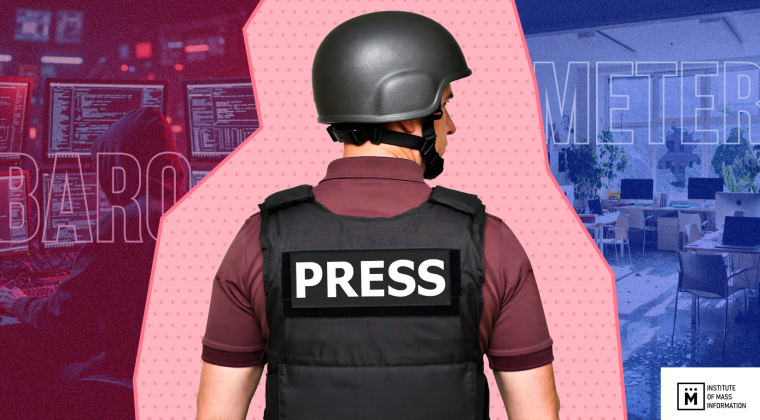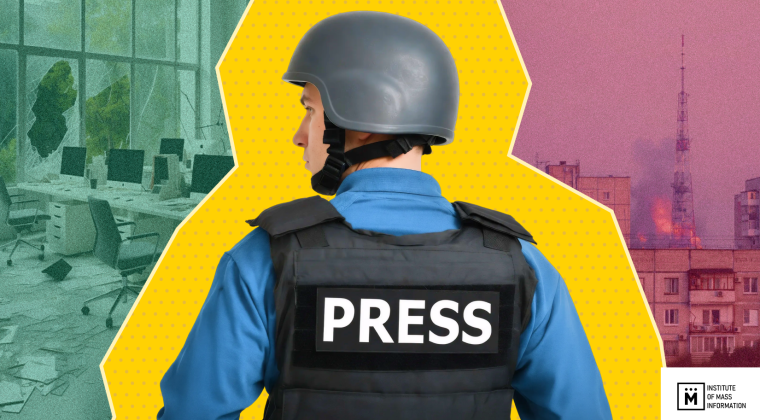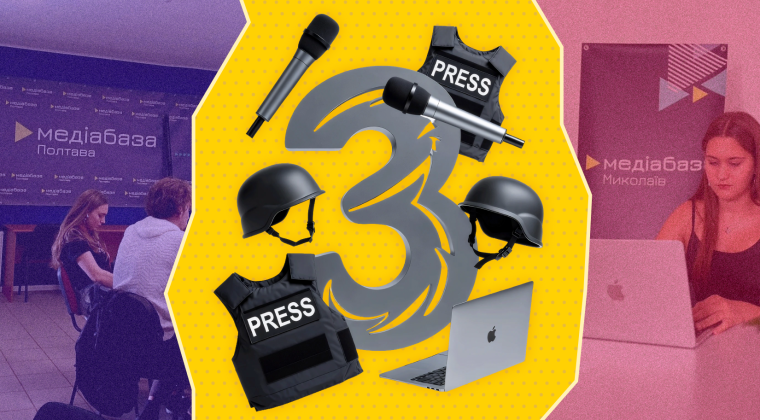Through decades, Russia has been investing a lot of resources in creating its own informational and cultural space. Ukraine, according to our northern neighbor’s plan, should always remain a part of this space. Dozens, maybe even hundreds of media outlets were working on this task: TV channels, websites, radio, and printed publications.
To keep Ukraine in its sphere of influence, Russia promoted its narratives in movies, theater, art exhibitions, music festivals, and at many other “cultural events”.
As people gained mass access to the Internet, Russian propaganda quickly mastered this field as well. Thousands of real and fake social media pages, bot farms and group chats – Russians and their proxies in Ukraine have been using all their channels to tell their version of our shared history, to speak about heroes and traitors, “one nation”, and May 9. It was these channels that opposed any Ukrainian-centric or pro-Western initiatives most loudly (be it Ukrainian movie dubs in theaters or signing an association agreement with EU countries).
These same channels were the first to justify Russia’s invasion of Ukraine in 2014 and 2022.
In the media support for the big war, the occupiers placed their bets on Telegram channels. Operational reports from the front line, news from the occupied territories, reports from the so-called warlords and posts on the occupation authorities’s pages – all these things can be found on Russia-controlled Telegram channels.
Some of them have existed for a long time, but only became active during the war. Others were created in February-March 2022 specifically to relay the Russian point of view on the invasion and justification of Russia’s crimes in Ukraine.
In this survey, we will try to understand how and when the largest Telegram channels were created, which of them Russian propagandists use to speak on war-related topics (using Kherson oblast as an example); who is behind these channels; how their audience has changed; how they cooperate with one another, as well as what are the central narratives spread by Russian propaganda in the occupied territories.
The occupation authorities’ “official” and personal channels
Telegram accounts became “official” channels of communication between the occupation administrations and the population from the get go. They appeared much earlier than official websites and are being filled more quickly and with more meaningful content.
Many of them have gone through multiple rebrandings. For instance, “Kherson Oblast Administration” channel used to be the official channel of the first occupation “state body” staffed by local collaborators – the “Kherson Oblast Rescue Committee” – before getting its current name and content.
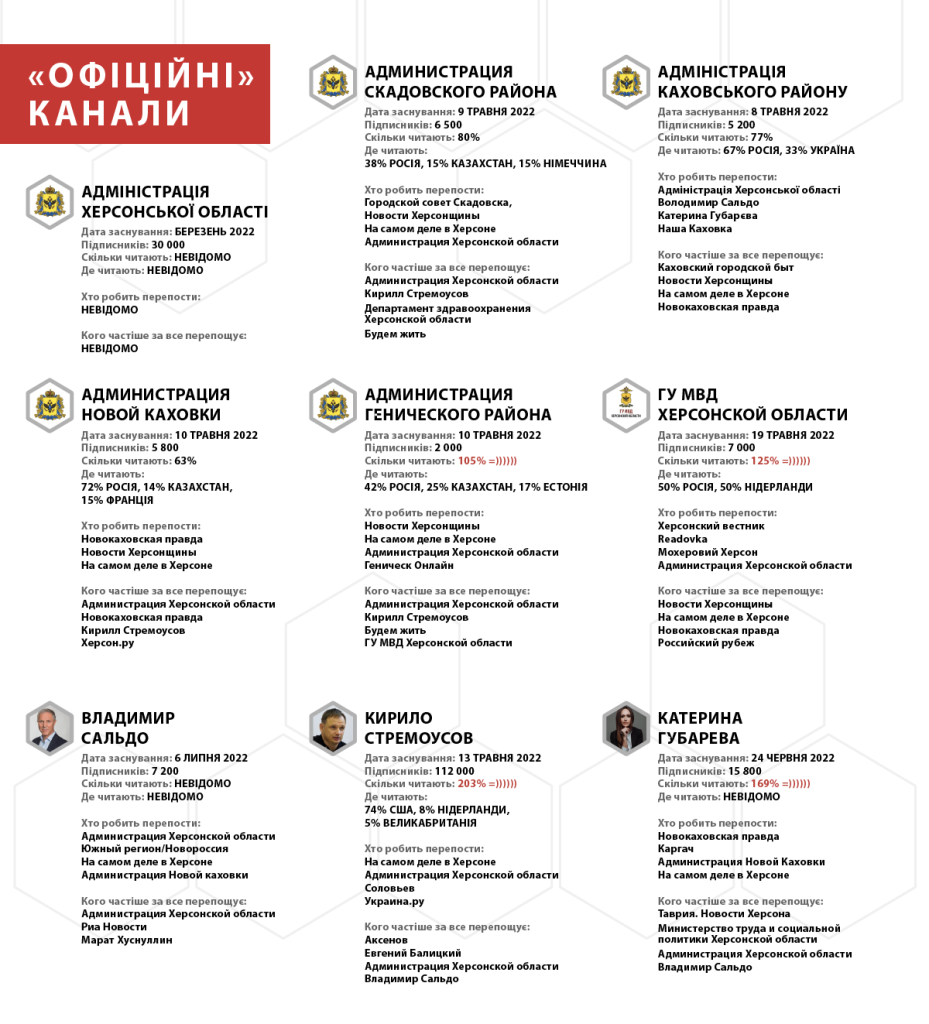
An April 2022, after military-civilian administrations were created, the “Committee” people renamed their channel to “Kherson Oblast MCA”. In autumn, as Volodymyr Saldo was in a Russian hospital, the channel got its current name.
It is currently impossible to check the channel’s metrics, because the Russian resource that allows to do so says that it has blocked the channel for violating their policy.
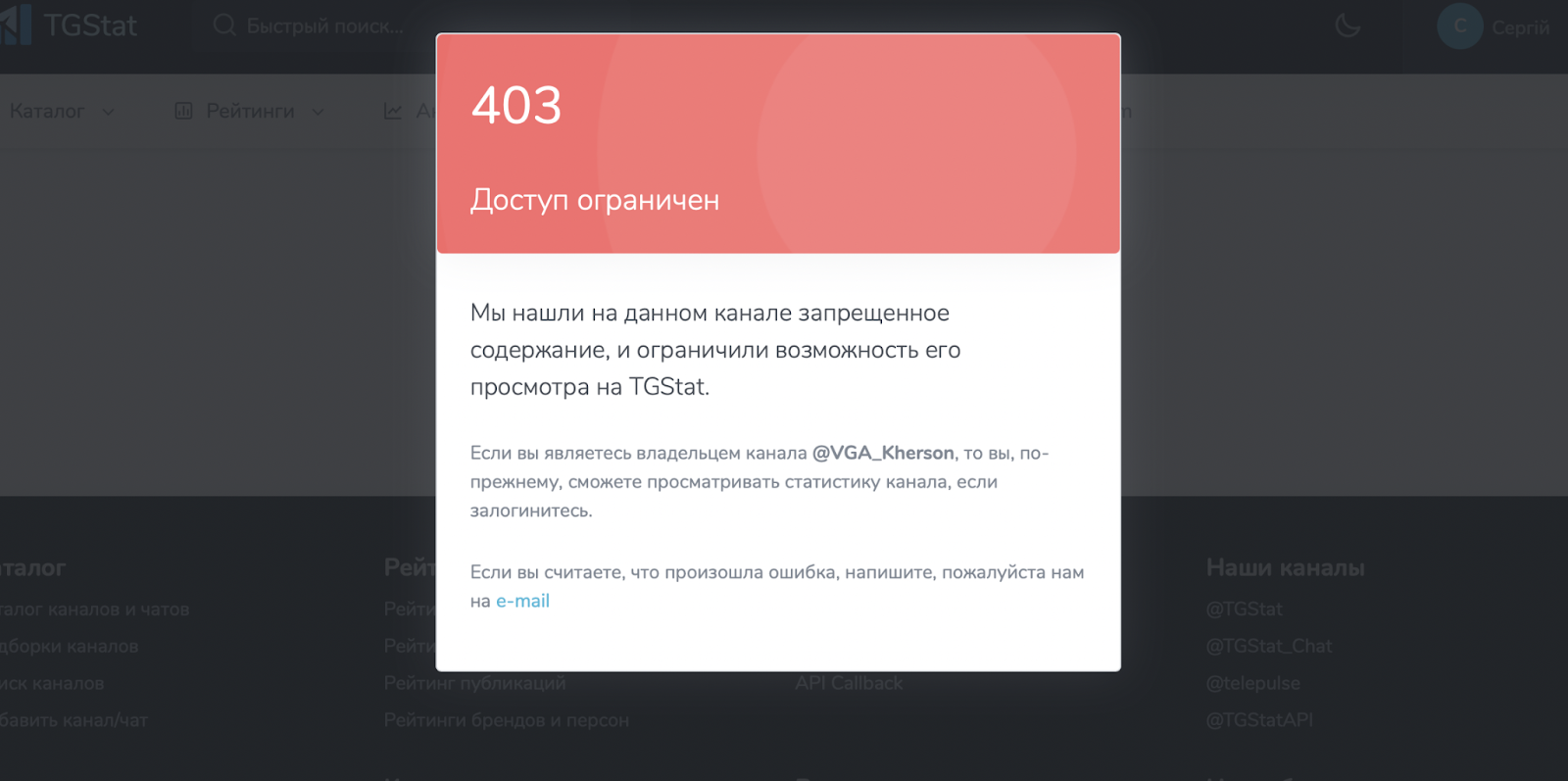
The channel’s content is typical: official messages, statements from Volodymyr Saldo and (less often) from Kyrylo Stremousov. Sometimes they share posts from the channels run by heads of Kherson oblast’s occupation administrations.
The channels of other “administrations” are almost no different. They, too, post statements, orders, and other fake documents issued by fake authorities.
Only the top management of the occupation administration is allowed to have personal channels.
Volodymyr Saldo and his deputies, Kyrylo Stremousov and Kateryna Hubareva, each have one. After YouTube blocked the channel run by Serhiy Moroz, an assistant to the local Gauleiter Kyrylo Stremousov, he created a Telegram channel, but the content and the audience there are their own thing.
Propaganda channels
It is quite difficult to say exactly how many Telegram channels the Russians have created to work in occupied Kherson oblast’s information space. After all, even while preparing this survey, we sometimes came across resources that had been created literally days ago that we had not heard of before.
To analyze this phenomenon, we chose about a dozen of the enemy’s propaganda mouthpieces which, in our opinion, are the main ones.
There are several characteristic features that unite them:
- time of creation – just before or immediately after Russia’s invasion on February 24, 2022;
- the audience – most of the “subscribers” are bots;
- complementarity – if tomorrow one or ten of them disappear, no one will notice;
- lies – each of them spreads a standard set of fakes and manipulations that are beneficial to Russia.
Let’s review some of them.
The channel “Key Events in Kherson” was created two weeks after Kherson was taken by the Russians – on March 14, 2022.
Only 19% of the subscribers are active. More than 60% of clicks from other resources come from Russia and Germany, with 14.8% being from Ukraine.
The channel’s subscriber count had three spikes, as if scheduled: in late April, July, and October. Each time, the channel’s audience grew by 20–40 thousand subscribers literally within a few days.
Channels such as “Key Events in Henychesk”, “Key Events in Chornobayivka”, “Key Events in Melitopol” quote this channel most often. Judging by these channel’s posts, they are run by non-local people and their management is centralized. For example, the authors can not tell the Dnipro’s left and right bank apart and often call Kherson districts by their official names Suvorovsky and Dniprovsky, while the locals typically use microtoponyms and the names of microdistricts. It is unlikely that a local person would write about an explosion in the Dniprovsky district instead of an explosion “at the KhBK.”
Of the Russian Telegram channels, “Key Events in Kherson” shares posts from “Topics. Important (GlavMedia)”. This is a news aggregator that is believed to be associated with a Krasnodar-based advertising company.
The channel “Actually, in Kherson” was created on April 2 and connected to the statistics on April 18, already at 25,000 subscribers. Currently, there are 26,000 of them. Here, the audience was growing in waves as well. The channel presently going through mass subscriber loss: minus 4,000 subscribers in three days. This usually happens due to the service blocking the bots which the channels use to pad up their statistics.
The channel usually shares posts from the Kherson oblast occupation administrations’ official pages, the “News from Kherson Oblast” channel, and propagandist Yuriy Podolyaka. The channel “Actually, in Kherson” is mostly quoted by little-known channels such as “News from Beryslav”, but every now and then, that same Podolyak or even the top propaganda resource “Ukraine.ru” quotes it, too.
By the way, of all the channels we analyzed, the similarly named channel “Kherson.ru” is about the only one that has a real owner listed on the tgstat.ru statistics service. It is also one of the few channels that has real readers.
Interestingly, this channel was created on February 20, 2022, a few days before the full-scale invasion. The channel’s first post was published at 14:50 on February 24. By evening, it had several posts with photos and videos of broken Ukrainian equipment. It was mostly making reposts or sharing someone else’s content. It was only two days later that original posts began appearing on the channel, and it became clear that it was kicking into full gear.
The channel has a little less than 20 thousand subscribers, of which 59% read the content.
The authors of this resource were not in Kherson as of April–May. This became obvious when the Russians completely cut off the Internet and mobile connection in Kherson oblast for several days. This channel, unlike others, continued to post.
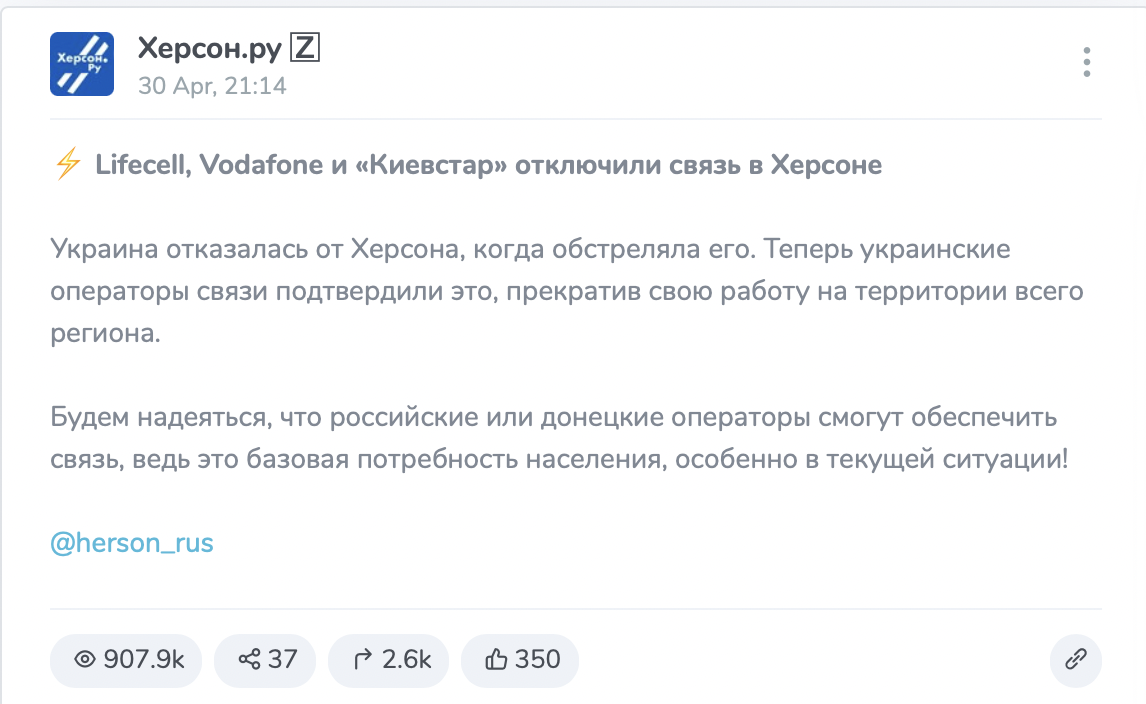
Simultaneously with “Kherson.ru”, on February 20, appeared the “Kherson People’s Republic” channel. Seeing as the two channels constantly repost from each other, they are closely affiliated. However, the “KhPR” made an obvious attempt to use bots to inflate their subscriber count.
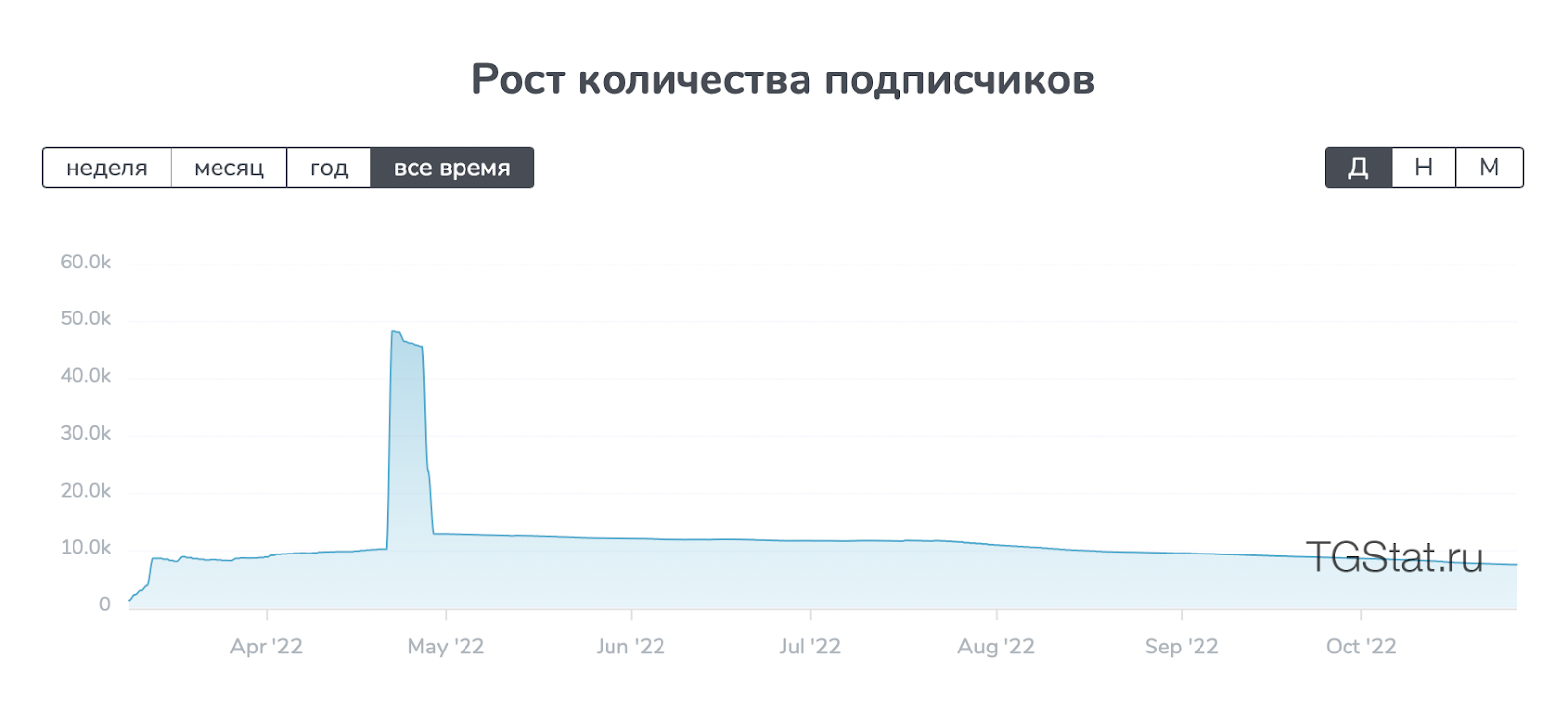
The graph clearly shows that it happened at the time when there was no Internet in Kherson oblast. These bots left the channel just as quickly as they subscribed to it. The website’s statistics still shows that it is read by 110% of subscribers. At the time of the spike, this figure exceeded 500%, and now the statistics are leveling out as people are gradually unsubscribing from the channel.
One of the top propagandists citing this channel is Zakhar Prilepin, who has made 13 reposts from it.
To understand the situation with Kherson oblast’s propaganda Telegram channels, we suggest you look at the infographic.

It clearly shows that most channels rebroadcast one another, and we only took into account the reposts that were made through the “share” button, not copypasted as original content.
In general, it turns out that most of the content on the pro-Russian Telegram channels targeting the Kherson audience are reposts from official channels and Russian state media. Original content in such channels comprises no more than 10–15%, which does not prevent them from becoming the primary source of gossip, fake news and messages in numerous group chats and pages on other social media and in messengers. And, most likely, this is precisely what the Russians created this army of Telegram channels for.
Who runs these channels?
Most Russian propaganda channels are anonymous. This is very convenient for propagandists, and the readers are not particularly bothered by it. But we still managed to find several authors.
First of all, it is known that the occupation authorities’ network of official Telegram channels is run by a whole team of people, which includes former trucker, former press secretary of the Kherson oblast occupation administration, and now assistant to Kyrylo Stremousov, Serhiy Moroz. According to our information, he does not run the team, but rather coordinates the work of several channels. Namely, the channel of Stremousov himself.
Most of the work is done by officials who went to work at these administrations. For example, Iryna Yeremenko runs the Chornobayivka MCA Telegram channel, according to the SBU.
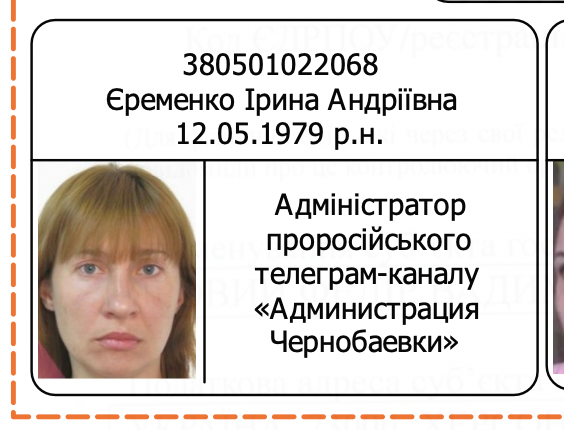
She is a former freelance journalist who has been hired by the town’s occupation administration.
The “Kherson Vestnik” Telegram channel is run by Olena and Hennadiy Shelestenko, who used to run a Facebook group of the same name even before the Russian invasion and never hid their pro-Russian views.
The “Kherson Oblast News” channel has a whole team of authors who work anonymously, but we know that one of the authors is Viktor Marchenko. His identity has been revealed while the so-called “media school” was taking place.
Before Russia’s invasion, this channel, as well as the website of the same name, were dormant. The website was being filled by bots collecting news from Kherson websites through parsing, and the Telegram channel had 120 subscribers an almost never updated. Now it has 11 thousand readers.
There are quite exotic characters among the authors. This summer, SBU investigators detained a 21-year-old man in Ivano-Frankivsk oblast who ran the “Kherson Republic” Telegram channel.
SBU investigators established that he had created the channel in April, after the start of the full-scale invasion. The posts were being published as original content, without reposts, which created the illusion of “first-hand news”. The channel’s main “newsmakers” and speakers were the Kherson oblast Gauleiter Volodymyr Saldo and his deputy Kyrylo Stremousov.
On October 31, the SBU completed the pre-trial investigation. The young man faces up to 10 years in prison.
As we wrote earlier, some of the authors of these channels are Russians who mix up concepts, toponyms, make factual errors, and do not fully understand the realities of the occupied Kherson oblast. But they continue their daily work of disinformation, deception, and incitement to enmity.
Key narratives
The network of Russian Telegram channels in Kherson oblast is designed to quickly cover the situation in the occupied areas, as well as to provide the key news related to the hostilities and the civilian life. They post statements of Ukrainian and Russian top officials.
This information is wrapped in a layer of propaganda terms and clichés that justify Russia’s invasion of Ukraine, discredit the Ukrainian Armed Forces, exaggerate the Russian army’s successes in every possible way, and disparage international partners who support Ukraine. All Russian Telegram channels in Kherson oblast feed into the alternative reality into which Russia has plunged.
One of Russian propaganda’s key narratives, which it has been actively promoting before the big war and continues to cultivate now, is that “Ukrainians and Russians are one people.” Along with this, the occupiers stress that “Kherson is a Russian city.”
The occupiers put up billboards with such mottos in several cities of the oblast, and representatives of occupation administrations often stress these talking points, as if trying to convince themselves they are true. They film videos wherein they tell their version of Kherson’s history, hang out portraits with quotes by Russian poets and other ideological content.
By constantly clinging to the past, the Russians are trying to justify their claims to the captured territories of an independent, sovereign state whose borders are recognized by the international community.
In late October, the occupiers stole the monuments of Fedor Ushakov, Aleksandr Suvorov, Grigory Potemkin, and Vasily Margelov from Kherson. Again, they justify their actions by tying them to their current ideology, which includes both the imperial and Soviet heritage. The Russians are openly committing crimes in the occupied territories, all while trying to convince the world that they are actually preserving their cultural heritage.
The “evacuation” of Kherson residents to the Dnipro’s left bank, which the occupation administration has been carrying out since October 19–20, is also relevant in this context. The occupiers justify this by saying they are trying to save the lives of “their” civilians. The propagandists call those who choose to stay in Kherson “waiters“, as they are waiting for the UAF and the Ukrainian authorities to come back.
The illusion of a peaceful life and “Russia is here forever” (but not for sure)
Another narrative that the invaders liked to push in the occupied lands of Kherson oblast is that “Russia is here forever.” This is how they tried to crush the morale of the Ukrainians who remained under occupation, to sow doubt and despair among them.
During their meetings with the people and in the media, Russians and their ideological collaborators often added that “Ukraine has abandoned you.” They said that the Ukrainian authorities have fled, but Russia has come to restore order.
To substantiate these claims, they used a narrative about the peaceful and calm life in Kherson oblast, which is “coming back” to being protected Russia. Preparations for starting the school year, distributing food kits, reports about Russian passports being issued to locals, news about various associations and unions being founded, and, of course, about the work of the occupation authorities that are “taking care” of ordinary citizens. In Kherson, the occipiers were organizing concerts of Russian performers, simulating theater openings and sports events. They were doing their best to convince people that nothing was wrong, and all hardships were temporary, and all it would take was a little patience.
The occupiers filled their information space with the phrase “Russia is here forever” even as they held the fake referendum. They devoted hundreds of posts on local Telegram channels to this subject. Of course, all those posts talked about the referendum with praise and approval; the occupiers quoted comments from people who uttered pre-writen statements about their support for Russia.
However, the successes of the UAF, the resistance movement, and all of Ukraine’s defense forces kept the occupiers on their toes. The Russian media tried to deny any successful attacks on infrastructural facilities which the invaders were using for their purposes, and also lied about their losses caused by the UAF striking ammo depots and personnel in Kherson, Nova Kakhovka, Kakhovka, Chornobayivka, and many other settlements.
Kyrylo Stremousov, Kherson oblast’s deputy administrator appointed by the Russians, is one of the most prominent media personalities on Russian channels in Ukraine’s South and has repeatedly denied the UAF’s counteroffensive actions in Kherson oblast.
If you count the losses of the Ukrainian military as reported by Stremousov, it looks like the occupiers killed at least 9,800 UAF soldiers in the South alone. And this is only during one offensive operation. Fantasy? No, anything is possible in the world of Russian propaganda.
However, the occupiers were soon forced to admit the objective reality. After facing problems with supplying their troops on the right bank of the Dnipro, caused by the UAF’s missile attacks on the main river crossings, the Russians started relocating their administration to the left bank. Together with collaborators and Russian supervisors, they took away the property from the right bank’s hospitals and diagnosing centers, ambulance vehicles, fire trucks, and office equipment from the offices of Ukrainian authorities and other organizations.
How the events on the front line are going to develop in the near future remains to be seen. However, as the occupation authorities are fleeing from Kherson, the “Russia is here forever” narrative looks highly dubious and laughable. Again, thanks to the UAF, which liberated several dozen settlements in Kherson oblast’s north throughout September and October, forcing the Russians to retreat.
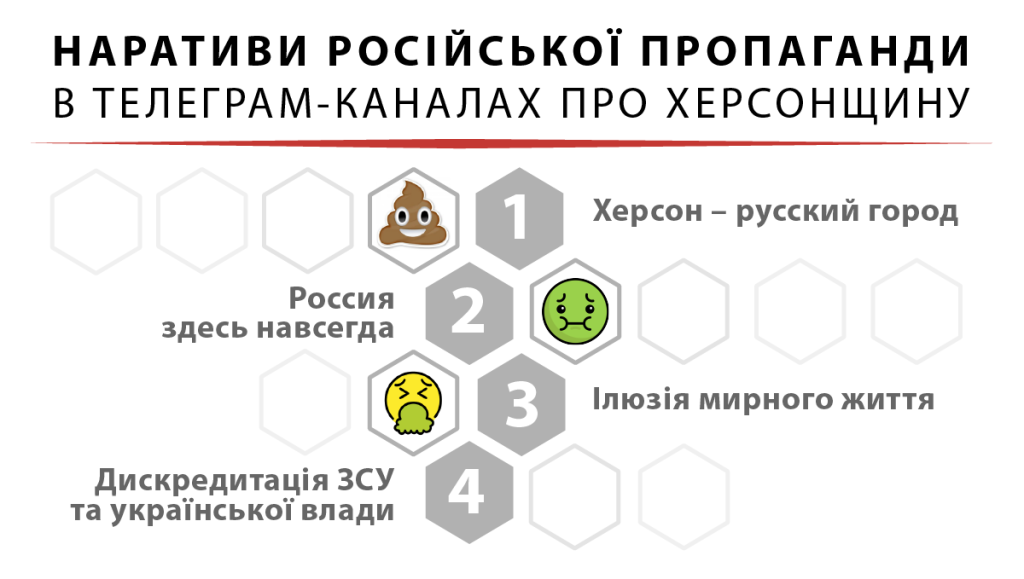
Discrediting the UAF
Another narrative that Russian propaganda has been persistently pushing is discrediting the Ukrainian Armed Forces. This is a typical narrative for a belligerent country: humiliating and dehumanizing the soldiers of the enemy’s army. Only among Russians it has its own distinctive characteristics: the vast majority of all their reports about “Nazi atrocities” are fiction or manipulation.
Russian Telegram channels talk about the Ukrainian military in several ways. The first one is as follows: the UAF soldiers are punishers who kill the civilian population, execute their fellow soldiers, and fire at civilian convoys. The second way is to portray them as weak, laughable, useless soldiers who are all drunkards and deserters.
“They loot the bodies of the dead: French journalists conducted a shocking investigation about the UAF soldiers,” “The UAF target residential areas in the city’s downtown,” “Nazis from the UAF destroy the Humanitarian Aid Center in Nova Kakhovka.” We often find such headlines in Russian media resources. They claim that it was Ukraine that killed the POWs in Olenivka, and that it is the Ukrainian Armed Forces firing at evacuation convoys and deliberately killing civilians.
One of Russian propagandists’s main tasks is to shift responsibility for the war crimes committed by the Russian army over to Ukrainians. They don’t care about facts. The goal is to create miltiple manipulative accounts of the events that often contradict one another, to blur what is real, to discourage critical thinking on the part of the audience, on the contrary, to make people stop trusting both Russian and Ukrainian media. As they like to say in Russia, “we will never know the whole truth anyway.”
This approach also works on the international audience. It reinforces the opinion favorable to Russia: they are not the only ones to blame for this war, Ukraine and the West, who left the aggressor no choice, are also responsible.
In addition, Russian Telegram channels spread anti-mobilization sentiments in various forms. Namely, they are panicmongering as the state is handing out conscription notices.
Of course, these are far from all narratives and psyops carried out by the Russian propaganda’s Telegram warriors. Every day they generate gigabytes of content aimed at exploiting sensitive topics and forcing people to accept their reality – a reality where black is called white, a war of aggression is liberation, and thousands of civilian victims in Ukraine are denazification and help for the Donbas.
Serhiy Nikitenko, Ivan Antipenko

